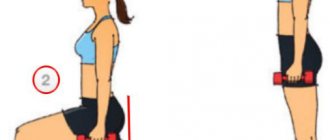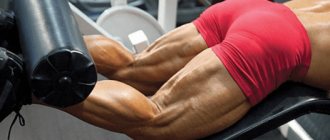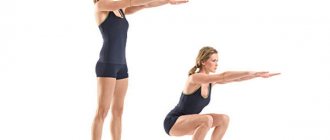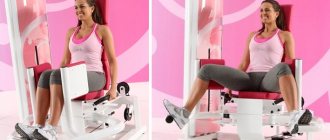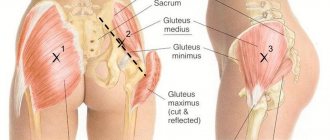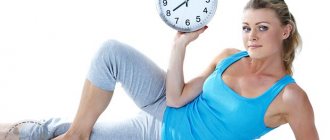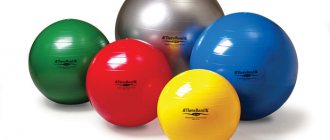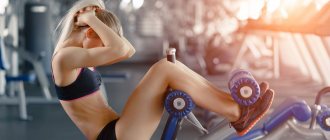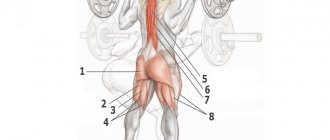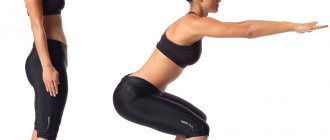We are all different, and this also applies to the shape of our buttocks. Some people in this zone do not have enough volume, while others, on the contrary, have too much of it there. However, trainers “prescribe” strength exercises for both: they allow you to correct the shape of the buttocks and make them more elastic. “Using a fitball allows you to use both the buttock muscles and stabilizer muscles in one workout,” comments Tatyana Yurina
, bodymaker at SuperPopa studio and author of the set of exercises that we will show today. “An undeniable advantage of this complex is also that this particular combination of exercises helps to work the gluteus maximus, minimus and medius muscles, that is, the entire area of interest to us, without exception.”
Ready to start class? Repeat after Tatiana.
How to build a workout
* Start your session with a warm-up.
5-7 minutes of joint gymnastics or aerobics at an average pace will be enough.
* Build a training session based on the circular principle.
“Perform the exercises sequentially, leaving no more than 40 seconds of rest between them
.
Rest between circles - up to 60 seconds. Start by performing two circles, gradually increase their number to four,” advises Tatyana.
* Perform each exercise for 10-15 repetitions.
“Increase the load gradually,” comments Tatyana Yurina.
* Watch the execution technique.
“Bending your knees to a straight or obtuse angle will help reduce stress on your joints,” says our expert.
* Exercise 2-3 times a week.
If possible, complement these workouts with a 20-30 minute cardio session.
To complete the complex, you will need a mat and a fitball (we wrote here how to choose one).
"Fold"
A fitball is an inflatable rubber ball with a diameter of 45-95 cm, which is used in fitness to work on muscle tone. We offer you a unique selection: 50 exercises with fitball
for all problem areas in visual animation! Thanks to the proposed exercises, you can strengthen the muscles of the arms, abdomen, thighs and buttocks, improve your figure, and get rid of sagging and cellulite.
Before moving on to the list of exercises with a fitball, let's remember how to properly exercise with a rubber ball so that the workout is effective and high-quality. We offer you 10 useful tips for training with a fitball at home or in the gym.
Features of performing exercises with a fitball:
1. While performing exercises with a fitball, you should be focused on your muscles and feel their tension. Try to train not for speed, but for quality.
2. Use in your workout not only exercises for your problem area, but also exercises for the whole body. To successfully lose weight, you need to work in a balanced manner on all muscle groups, and not just on the stomach or just, for example, on the hips.
3. Remember that the more you inflate the fitball, the more difficult
to do exercises. If you are just learning to train with the ball, do not inflate it until it is completely elastic at first.
4. If you don’t know how to structure a workout, then use the circular principle. Take 5-6 exercises and alternate them with each other in several rounds. The second part of the article offers specific exercise programs that can be taken as a basis.
5. All 50 exercises with a fitball that we offer are divided into 4 groups: for the upper body (shoulders, arms, chest), for the core (back, stomach), for the lower body (hips and buttocks), for the whole body (all major muscle groups are involved).
6. Exercises with a fitball are especially effective in working on the muscular corset.
, so even exercises with a ball for the hips and buttocks help strengthen the abdominal and back muscles as well.
7. For most of the proposed exercises, you will not need any other additional equipment other than a fitball.
8. If it is difficult for you to repeat an exercise with a fitball (for example, due to insufficient balance), then either modify it into a more simplified version, or do not perform this exercise at all for now.
9. Exercises with a fitball are an excellent way to prevent back and lower back pain.
.
All exercises with a fitball are presented in GIF pictures so that you can clearly see the process of implementation. GIFs tend to speed up the process of completing an exercise, so don't try to rely on the speed shown in the images. Exercise at your own pace, with focus and full concentration
.
Fitball exercises for buttocks
Fitball exercises for buttocks
When you work on problem areas, particularly the thighs and buttocks, it is not uncommon for results to stagnate. And so that your workouts are not in vain, periodically give your body a shake-up. One of these simple but effective techniques is exercise on a fitball for the buttocks.
Fitball is a gymnastic ball with which you can:
- Load several muscle groups at the same time;
- Improve coordination of movements;
- Correct your posture;
- Develop flexibility and plasticity of the body.
Unlike static exercises, exercise on a fitball keeps all muscles tense throughout the entire work. Due to its unstable surface, the apparatus forces your body to maintain balance throughout the workout. This, in turn, involves not only the target muscles of the body. Moreover, the number of exercises is so numerous that it allows you to work out all muscle groups, and not just pump up your buttocks on a fitball.
{module Adsense block in the middle of the button}
Many people believe that exercising with a fitball has contraindications. Not at all, training with this gymnastic ball is possible for people with an initial level of training and even with poor health. In addition, the back is not strained during work, which is especially important for those who have a number of problems with the spine.
But still, before you start exercising on a fitball for the buttocks, you should choose the right diameter of the projectile for yourself. The latter must be chosen taking into account your height. Sit on the ball, and if your legs are bent clearly at a right angle, then the equipment is suitable for you. The diameter of the projectile can be different - 45, 55, 65 and 75 cm.
So, let’s determine the advantages of a gymnastic ball:
- Light in weight, but can withstand up to 300 kg;
- Mobile – easy to move around the hall;
- Multifunctional - it is possible to work all muscle groups;
- Absolutely safe - it deflates quickly and easily, and will not burst even if cut.
- There are no restrictions on the level of physical fitness.
Now let’s get down to the practical part and try to pump up your buttocks on a fitball using the following exercises. Perform 3-4 sets of 12-25 repetitions.
1. The easiest exercise is jumping . During work, the buttocks should not come off the surface of the ball, and the feet should not leave the floor. You can take medium weight dumbbells in your hands.
2. Bridge for the buttocks . The exercise works the muscles of the butt, thighs and calves, because you literally have to hold the ball with your feet. Be sure to hold for a few seconds at the top point.
3. Leg abduction squats are an effective technique for the gluteal muscles and hamstrings, especially if you use dumbbells.
4. Wall squats . Slowly lower yourself to the bottom until your thighs are parallel to the floor, and just as smoothly return to the starting position.
5. Hip extension lying on the ball - the gluteal muscles and the back of the thigh work.
Some, especially overweight people, are afraid that the ball may burst while working. Don't worry, it will happen. The fitball is equipped with a special anti-explosion safety system. And when a hole appears in the ball (no matter what), it will simply begin to slowly descend. That's all.
{module Adsense block in the middle block (separate)}
We bring to your attention another effective set of exercises on a fitball for the buttocks:
Examples of ready-made training programs with fitball
If you want to exercise with a ball, but don’t know where to start, we offer you a ready-made exercise plan with a fitball for beginners, intermediate and advanced levels
. You can practice according to the proposed scheme, gradually adding or changing exercises at your discretion.
Plan 1: Fitball exercises for beginners
Fitball training for beginners will consist of two rounds of 5 exercises in each round. Each exercise is performed 10-15 repetitions one after another. After finishing the round, repeat it in 2-3 circles. Then move on to the second round. Take breaks as required, but no more than 1 minute.
First round:
- Sumo Squat
- Superman (Superman with fitball)
- Hip Raise
- Crunch
- Lateral Leg Lifts on Knees
Second round:
- Squat Wall
- Rollout Ball
- Leg Drops
- Side Plank on Knees
- Reverse Lunge
Execution: 10-15 repetitions of each exercise with a fitball, the round is repeated in 2-3 circles, then proceed to the next round.
Plan 2: exercises with fitball for intermediate level
An intermediate level exercise ball workout will consist of three rounds of 6 exercises in each round. Each exercise is performed 15-20 repetitions one after another. After finishing the round, repeat it in 2-4 circles. Then move on to the next round. Take breaks as required, but no more than 1 minute.
First round:
- Russian Twist
- Knee Tuck
- Lower Back Extension (Hyperextension on a fitball)
- Scissors
- Reverse Lunge
Second round:
- Leg Curls (Fitball roll on the back)
- Leg Raise
- Decline Push-up
- Knee to Elbow
- Skater
- Sit-ups (lifting the body)
Third round:
- Side to Side Knee
- Touch Leg Lift (Touching your feet on a fitball)
- Squat Wall
- V-Sits One Leg
- Sidekick (Swing your leg to the side)
- Leg Rotations
Execution: 15-20 repetitions of each exercise with a fitball, the round is repeated in 2-4 circles, then proceed to the next round.
Plan 3: Exercises with a fitball for advanced levels
An advanced exercise ball workout will consist of four rounds of 6 exercises in each round. Each exercise is performed 20-25 repetitions one after another. After finishing the round, repeat it in 3-4 circles. Then move on to the next round. Take breaks as required, but no more than 1 minute.
First round:
- Pick Crunch (Plank Butt Lift)
- Flutter Kicks
- Squat One Leg
- Lower Back Extension (Hyperextension on a fitball)
- Plank Rollouts
- Leg Raise
Second round:
- Incline Push-up (Push-ups on a fitball)
- Plank Sidekicks (Swing your legs to the side in a plank)
- Bicycle
- Squat Jack
- Hip Raise One Leg (Lifting the buttocks with one leg)
- Lateral Leg Lifts
Third round:
- Side Plank
- Leg Lift Bridge
- Plank Kick (Touching your elbows in a plank)
- Ball Passover
- Push-ups Leg Lift
- Sidekick (Swing your leg to the side)
Fourth round:
- Plank
- V-Sits (V-fold)
- Mountain Climbers Fast
- Leg Raise on Ball
- Sumo Squat
- Crunch Touch Knee (Double Crunch)
Execution: 20-25 repetitions of each exercise with a fitball, the round is repeated in 3-4 circles, then move on to the next round.
Workouts using fitballs are usually associated with gymnastics for pregnant women or exercises during the recovery period after childbirth. A large ball is well suited for high-quality training of the muscles responsible for stabilizing the hips, pelvis, and spine. Suitable for people who are looking for an answer to the question of how to pump up their butt using a fitball.
The simulator was developed in the middle of the last century in Switzerland (another name is the Swiss ball) and was intended to solve problems with the musculoskeletal system. It develops the back muscles well, shapes posture, trains coordination of movements and a sense of balance. Later it turned out that the fitball is useful for everyone who decided to strengthen the core muscles, develop flexibility, slimness, and is suitable as an auxiliary exercise machine for the gluteal muscles.
How to choose gymnastic equipment for training?
To choose the right ball for practice, you need to consider the following:
- The diameter is calculated using the following formula: Your height minus 100 centimeters;
- Having chosen the appropriate diameter, you need to sit down with your feet pressed to the floor, your thighs should be parallel to the floor and your knees perpendicular;
- bright colors will bring more positive emotions and a boost of vigor to your workout;
- Please note the presence of an anti-explosion system, designated ABS or BRQ.
If you add equipment in the form of a Swiss ball to regular exercises, they will bring more effect, help strengthen more muscle groups, and improve flexibility. Fitball for fitness is gaining more and more popularity due to the ease of training with it and the absence of contraindications. You can pump up your buttocks using a fitball only by following the correct technique and regularity. To achieve even better results, it is better to perform the entire set of exercises on a fitball, alternating them or combining them in one day.
Recommended entries:
You need to be logged in to leave a comment.
Workouts using fitballs are usually associated with gymnastics for pregnant women or exercises during the recovery period after childbirth. A large ball is well suited for high-quality training of the muscles responsible for stabilizing the hips, pelvis, and spine. Suitable for people who are looking for an answer to the question of how to pump up their butt using a fitball.
Is it possible to pump up your butt on a fitball?
What are the benefits of a fitball for the buttocks? Many practicing trainers claim that the main benefit of the Swiss ball is to strengthen the stabilizer muscles. These are deep-lying small muscles, they are rarely involved in regular training, are little loaded and are not visible. We are talking about the small and medium gluteal muscles. The middle muscles are only partially stabilizing and influence the shape of the buttocks. The gluteus minimus muscles, occupying 1/7th of the gluteal muscles in volume, do nothing for the appearance of the butt. Stabilizers do not experience dynamic, but isometric contractions. It is possible and necessary to strengthen the endurance of such muscles, but increasing their muscle mass is unlikely. Conclusions - it is impossible to pump up your butt using a fitball, but including the exercise in your training has a tangible practical meaning.
Basic exercises for the buttocks on a fitball
Fitball is considered one of the least dangerous equipment, but it is still recommended to start classes with the simplest exercises. Fitness club trainers are often asked if it is possible to pump up your butt by jumping on a fitball. The answer is usually: no, but you'll have fun. Do the exercise correctly. Sit on the ball, keep your back straight, and press your feet firmly to the floor. Proceed to jumping without lifting your feet from the floor and the remaining fulcrum from the ball. Try to make jumps rhythmic, as fast and energy-consuming as possible. Don't forget to tighten your gluteal muscles. The exercise lasts 5–7 minutes, but this is individual, as is the number of approaches.
The plank on a fitball is quite effective for the back, abs and buttocks. Kneel next to the apparatus, rest your elbows and forearms on the ball, straighten your knees and take a plank position. The retention time can be gradually increased from a few seconds to a minute. The number of repetitions from 5 to 10 should also be increased gradually as training progresses. If you persistently look for a way to pump up your butt on a ball, then in the future the exercise can be complicated by alternately moving your legs back. Even if this does not bring you closer to your goal, at least at first it will give you a little pleasant adrenaline, and in the end it will increase your sense of balance.
Anticipating the question of young mothers about how to pump up their butt on a fitball while rocking a child, we can say that there are two answers: short and detailed. Let's start with a brief one - sequentially. Now we will be consistent and give a detailed answer. First you need to rock the baby to sleep, and then start training. If the first half of the plan is a success, then the second will go smoothly. If the child does not fall asleep, then you can try doing a glute bridge on a fitball. As a rule, this switches the child’s attention to the contemplation of an unusual phenomenon, and he becomes silent in surprise.
To perform the exercise, you need to lie on your back on a gymnastic mat, spread your arms to the sides, and place your ankles on a Swiss ball. Then raise your butt up so that your body forms a straight line with your legs straight: your shoulder blades and the back of your head rest on the mat, your ankles rest on the ball, the angle between the mat and your body is 25-30º. After this, bend your knees, rolling the fitball towards you until you rest your feet on it, and the angle between the mat and your body reaches 75–80º. At the top point, try to tense the muscles of your buttocks. Repeat the exercise 15–20 times.
You can perform exercises on a fitball at home, or under the guidance of an experienced trainer, for example, at.
Fitball is a special sports equipment in the form of a ball for fitness. The ball can be used not only by absolutely healthy young people, but also by the elderly, pregnant women, children, and especially those who have problems with excess weight.
This ball can be used both for exercise therapy and the gym, and for exercises at home. With its help you can pump up the muscles of the abs, thighs and buttocks.
Set of exercises
How to pump up your butt on a fitball? The main rule of any training is regularity. Classes must be carried out continuously over a long period of time. If you do butt exercises every other time, you will not be able to achieve any results.
You need to do at least 4 workouts per week. The minimum lesson time is half an hour. Gradually, the time needs to be increased, as well as the load on the legs and buttocks.
There is one more rule that needs to be taken into account. You cannot do the same exercises for the gluteal muscle. Gradually, the body gets used to the chosen set of exercises, and they cease to have any effect.
The person continues to train, increases the load, but no changes occur to the body. In this case, you need to choose a different complex and temporarily abandon the old, familiar exercises. It's best to vary the exercises constantly.
Before training (1 hour) you should not eat.
Simple exercises on a fitball:
- Plank.
The plank is one of the simplest exercises that affects not only the gluteal muscle, but also the muscles of the abs, arms, legs and back. Kneel in front of the ball, lean on your elbows and gradually rise up. The back should be straight. You must remain in this position for 20 seconds. You need to do it in 3 sets of 20 seconds. After some time, the duration must be constantly increased. It is worth noting that in the plank position the whole body should be tense.
- Plank with alternating leg abductions.
The body position should be the same as in the first exercise. Only now you need to take your legs up one by one. You need to hold your leg in this position for a few seconds, then change it. Perform 10 times with each leg for 4 approaches.
- Scissors.
You need to rest your hands on the floor, put your feet on the fitball. Lift them one by one, straining your thigh muscles. You should raise your legs 10-15 cm above the ball. With each swing they must be held for a few seconds. Then lower it smoothly. Repeat 15 times. Perform 4 approaches.
- Jumping from a squat position.
Take the ball in your hands and hold it directly in front of your chest, with your feet shoulder-width apart. Jump up sharply, straining your muscles. The arms with the fitball should be extended during the jump. Return to the starting position and bring your hands with the ball to your chest again. Perform 20 times. The minimum number of approaches is 2.
Complex set of exercises
- Gluteal bridge.
This is one of the most effective exercises that works all the muscles of the buttocks and legs. To perform it correctly, you need to lie on your back and raise your ankles, resting them on the ball. Raise your buttocks off the floor, tensing them as you do so. Slowly lower without touching the floor. Repeat 50 times. Take a short break and then repeat 50 more times.
- Bridge with alternating leg raises.
The starting position is exactly the same as in the previous exercise. Only now, after raising the buttocks, the legs need to be moved back, bending them towards the chest. Do 3 sets of 10 reps with each leg. This exercise is much more difficult than the first, but also more effective.
- Hip abduction to the side.
Stand sideways on one knee, lean on the ball with both hands and move your bent hip to the side. Then change position and move the other hip to the side. Perform 20 times.
- Squats with weights.
To perform this exercise you will need a ball and dumbbells. Place the fitball against the wall and lean your back on it. There should be dumbbells in both hands. Do a deep squat and return to the starting position. Repeat 15 times. Rest a little and do 10 more squats.
This is not the entire list of exercises that can be performed at home with a fitball.
How to choose the right fitball for fitness
When choosing a fitball, it is necessary to take into account various parameters that allow you to achieve the desired effect and are responsible for the quality of the ball.
One of the main criteria when choosing a fitball for fitness is safety:
- Resistance to ruptures - inside the ball there must be a built-in anti-burst system, thanks to which the fitball does not burst or tear apart if damaged, but slowly deflates.
This way you can avoid injuries during fitness activities. It is necessary to pay attention to the presence of the ABS or BRQ designation on the ball.
- A hand holder in the form of staples, handles or horns reduces the likelihood of injury. The holder is especially relevant for pregnant women and children.
Sometimes the manufacturer additionally makes a stand in the form of legs, which helps maintain balance during exercise.
The surface of the fitball can be smooth and massage, depending on the desired purpose:
- The smooth surface is suitable for sports and recreational training for children and pregnant women.
- The massage surface is used for relaxation and exercise therapy. This ball will help relieve fatigue and tension after physical activity.
When choosing a fitball, the angle between the shins and thighs should be 90°, thus the weight of the person sitting on it is evenly distributed and this prevents injury to the joints.
The diameter of the fitball should correspond to the person’s height:
- 55 cm – the smallest diameter is suitable for children 5-10 years old;
- 65 cm – height should be from 150 to 170 cm;
- 75 cm – height from 170 to 190 cm;
- 85 cm – if height is above 190 cm.
You can also select a ball according to the size of your hand by first measuring the distance from your shoulder to your fingertips:
- 45 cm – length according to hand measurements is at least 55 cm;
- 55 cm – measurements 56-65 cm;
- 65 cm – arm length 66-75 cm;
- 75-90 cm – arm longer than 75 cm.
Also, the ball must be of high quality, then it will last a long time, and the likelihood of injury with it will be lower. When choosing a ball, you need to pay attention to the following parameters:
- seams - should be practically invisible, and should not cause discomfort during exercise;
- nipple - completely pressed inward and cannot be felt;
- the fitball is evenly inflated and corresponds to the stated size;
- moderate rubber smell;
- material that is warm to the touch indicates good quality.
The fitball can withstand a load of up to 300 kg, but given the activity of the trainee, the maximum weight of a person should be up to 130 kg.
If you weigh more, you need to use the help of a trainer or order a special ball that can withstand such loads.
Basic rules for performing exercises with a fitball
By following simple principles when training with a fitball, you can achieve quick and long-lasting results. The basic rules for training with a fitball are given in the table.
| Principles | Description |
| Quality training | When doing fitness, focus on the tension of the muscles being trained, and not on the pace of the exercise. |
| Complex exercises | Do not dwell on problem areas: thighs, buttocks and abs. Losing weight will be more effective if you train the whole body |
| Increasing load | The more you inflate the fitball, the more difficult it is to perform exercises with it, so you can gradually increase the complexity of the tasks |
| The principle of circular exercises | Beginners are advised to choose 5-6 exercises for themselves and alternate them several times. |
Effective abdominal exercises
Using a fitball, you can pump up all abdominal muscle groups thanks to the following exercises:
- Sit on a fitball, rest your feet on the floor, keep your arms crossed on your chest. Gradually, using your legs, lean back.
During the exercise, your back should rest against the ball, and your knees should be under your ankles. When performing the exercise, the head is suspended, but does not tip back.
While in this position, begin to perform crunches at a slow pace, starting with the head, then involving the shoulders and back. There should be a feeling of tension in the abdominal cavity.
Do 8-10 repetitions in 2 sets. Rest between sets for about 60 seconds.
- You need to take the same position as in the previous exercise, but your hands are on the back of your head, your fingers are not crossed.
Perform in the same way as the previous one, 10 repetitions in 3 sets. The break between approaches should be reduced to 30-40 seconds.
- The starting position remains the same. There is a ball or dumbbell weighing 1-3 kg in your hands, your arms are straightened and located near your ears.
The exercise is performed with outstretched arms for 15 repetitions in 4 sets, then the number increases to 20 repetitions.
2 more exercises for the buttocks on a ball of increased difficulty
If you have fairly good physical fitness and want to work your gluteal and other muscles even more effectively, the complicated exercises presented below with a ball for the abs and buttocks are suitable for you.
Gluteal bridge
The glute bridge is a complex exercise aimed at working the abdominal muscles, hips and buttocks. Improves coordination and endurance of the entire body. Be sure to monitor your breathing and do not squeeze your stomach so that oxygen can be distributed well throughout the body.
Technique:
- Starting position - lie on the mat on your back, feet stand on the ball and pressed tightly against it;
- As you inhale, you need to push your pelvis upward. Watch your lower back; it should not bend too much. At the top point, the muscles of the abs and buttocks will be maximally tense. It is advisable to stay in this position for a moment.
- As you exhale, gently lower your pelvis onto the mat.
It is necessary to perform 10-15 repetitions in 3-4 approaches.
More details in the video:
Effective exercises for the buttocks
You can significantly tighten the muscles of your buttocks by performing simple exercises using a fitball:
- Lying on your stomach on a fitball, your arms are bent behind your head, your head is looking down, your legs need to be straightened and your toes resting on the floor. As you inhale, the back does not tense, the body is stretched forward. Return to the starting position as you exhale.
The difficulty of the exercise lies in maintaining balance. To begin with, 10 repetitions in 3 sets will be enough. Gradually increase to 20-25 times.
- Lie on the floor with your legs bent and place a fitball under your feet. Next, pressing your lower back to the floor, try to lift your buttocks up as much as possible, while holding back as much as possible.
You need to perform the exercise starting with 10 repetitions of 2 approaches, bringing up to 20-25 times.
- Place a fitball under your shoulder blades and lift your pelvis without lifting your feet off the floor. Start with 10-15 repetitions in 3 sets, working up to 20-30 times.
The best exercises for buttocks and thighs
Fitness using a fitball is one of the easiest and least traumatic activities. Suitable even for people with back problems or during the recovery period after injuries. You can exercise with a fitball at any age, during pregnancy and after the birth of a child, at any level of physical fitness. The most popular are planks with emphasis on a fitball, lifting it with your feet, or squats with a ball. Any standard exercise can be varied and complicated with the help of this sports equipment.
Hyperextension
How to do the exercise correctly:
- Lie with the middle of your stomach on the fitball, take a relaxed position, as if hanging down.
- Place your feet on the floor and fold your arms across your chest.
- Take a breath.
- The torso should be extended in a straight line.
- Exhaling, return to the first point.
For beginners, it is recommended to perform 10 repetitions in three sets.
Thanks to intense movements on the ball and the simultaneous inclusion of large muscles in the work, you can effectively work out the main problem areas: buttocks, back of the arms, inner thighs, waist.
Wall Squats
Technical points in the exercise:
- Press the ball firmly with your lower back against a horizontal, stable surface.
- Exhaling, slowly squat, rolling the ball. Knees come forward.
- Fix in the lower position, maintaining tension in all muscles.
For untrained athletes, it is recommended to start with 10 squats in three sets.
Fitball exercises are also useful for young mothers to restore their usual slimness. Thanks to the soft, elastic surface of the ball, girls can perform simple exercises in the first months after the birth of the baby.
Jumping
Training Features:
- Sit your butt on a fitball.
- Do jumping movements without lifting your buttocks.
- The faster you do jumping jacks, the more calories you will burn and the better your gluteal muscles will work.
Beginners are recommended to start with 3 minutes. Advanced athletes jumping for 5-7 minutes a day achieve impressive results in the form of pumping up beautiful legs and buttocks.
With the help of a fitball, you can conduct intense aerobic training aimed at getting rid of extra pounds.
Gluteal bridge
The nuances of the correct bridge exercise technique:
- Lie on your back and press your feet firmly against the ball, raising your legs and bending them at the knees.
- Inhaling, slowly lift your pelvis up, fix the position, tensing your muscles.
- Exhaling, slowly return to the starting position.
This type is more suitable for advanced athletes who are physically prepared. Perform 12-15 repetitions in three passes.
By systematically performing exercises on a gymnastic ball at least three times a week, you will achieve what you want - your waist will become thinner and your figure more toned.
Reverse bridge: raising the pelvic area while rolling the apparatus
Subtleties and correctness of the reverse bridge:
- Lie with your back on the floor.
- Extend your legs and place them on top of the ball.
- Hands lie freely on the floor.
- As you inhale, lift your pelvis up, while simultaneously rolling the ball closer to you with your feet.
- While raising your legs, tense the muscles of your butt, thighs and abs as much as possible.
- Exhaling, return to the starting position without touching the floor with your pelvis.
This activity is suitable for people with well-trained muscles and advanced athletes. Perform from 12 to 20 repetitions in three passes.
Perform a set of exercises on a fitball regularly, at least three times a week, alternating a day of exercise with one or two days of rest.
Effective hip exercises
Exercises on a fitball involve not only the muscles of the buttocks and abs, but are also suitable for working out the thighs, which makes training with it comprehensive.
The exercise is performed standing, the fitball is between the legs near the knees. The ball does not touch the floor surface. You need to gradually squat until your knees form a right angle, then you need to hold the ball in this position for 30-40 seconds. Perform 15-20 repetitions in 2 sets.
The exercise is performed while lying on the floor, arms are located along the body, calves and heels should be on a fitball. The hips must be lifted up, lifting them off the floor, and a slight burning sensation should be felt in the muscles of the abs and thighs.
To maintain balance, hold on with your hands. Take a deep breath, without removing your feet from the exercise ball, and raise your knees towards your hips. Hold this position for several seconds and, as you exhale, straighten your legs. Increase the number of repetitions to 10-12 times.
Stand in front of the ball, throw one leg over it, rest your toe on the floor with the other leg, or stand on your shin. Gradually squat on one leg, while the second leg should not fall off the fitball. You need to maintain balance with your hands, your back should be straight and not lean forward.
Squat as you exhale, while inhaling, return to the starting position. Perform 10-15 times, 2 approaches on each leg.
How to practice with a ball
Training complexes with a gymnastic ball are varied. The appropriate ones should be selected according to the assigned tasks. There are separate complexes for training the muscles of the legs, abdomen, chest, and so on. Before starting classes, it is recommended to make sure there are no contraindications.
Exercises with a fitball for the abdomen and core muscles
To strengthen the abdominal and core muscles, it is recommended to carry out training that includes complexes of twisting and lifting the body. To perform it correctly, you need to sit on a fitball, using it as a support for your back. You can also perform body lifts while standing on a ball face down and placing it under your chest.
Leg raises from a lying position on the floor are relatively simple. To increase efficiency, they should be performed by placing a fitness ball between the ankles or knees. This complex can be used as a warm-up before the main workout.
Exercises that include leg lifts are especially effective. To perform them, you need to use the ball as a support, placing it under the lumbar area. To prevent falling, you need to hold onto the handrail or any solid object located above your head with your hands. To get results, it is important to train at least three times a week.
Exercises with a fitball for hips and buttocks
To firm and increase the volume of the buttocks and thighs, it is recommended to perform the following exercises:
- While lying on the floor, place your legs bent at the knees on a ball, and then lift the lumbar area and buttocks. You need to raise your legs together. You can complicate the task somewhat - you should lift your torso by stretching one leg up and resting the other on the ball.
- Holding the ball above your head, perform deep squats with your knees shoulder-width apart.
- Leaning on the ball with the right or left half of the body, lift the leg on top. Change body position to the opposite and repeat.
When performing exercises, you need to stretch the muscles, feel how they tense during the work. The benefits of classes conducted “for show” are minimal.
Exercises with a fitball for the upper body
The most effective exercise for the upper body is push-ups. They can be performed by leaning on the ball with your hands or, on the contrary, placing your feet on it. You can also combine the above options. To strengthen the chest muscles, it is recommended to train using additional light dumbbells, the weight of which should be increased over time. To perform exercises with dumbbells, you need to lie on your back, using a ball as a support, and then make vigorous swings with your arms.
Doing exercises with dumbbells is not recommended for beginners. You need to start more complicated training only after mastering the work with a gymnastic ball.
Exercises with a fitball for the whole body
The following exercises will help tone the muscles of the whole body, strengthen them, and increase elasticity. They should be performed as the final stage of training. For example, the following exercise is useful: holding a ball in your hands, you need to jump with squats.
You can also do this: put your hands on the floor, place your feet on a fitball. Alternately lift one leg while holding the second ball. As a finishing touch, you need to place the ball under your stomach, and then imitate walking, raising your arms and legs alternately.
Static exercises with fitball
Static exercises using a fitball will help you use the muscles of the whole body at the same time. To perform such exercises, you need to keep your body as still as possible.
Static exercises with a fitball for the abs, buttocks, and thighs will have a tightening effect, increase muscle tone, and improve coordination of movements.
Bend your elbows and lean your elbows on the ball, your feet rest your toes on the floor and do not bend. You need to find a balance point on the ball and try to maintain a straight line for 8-10 seconds. You should control your pelvis: do not tilt it down and do not lift it too high.
To perform, rest your shoulders on the floor, raise your back and hips, bend your legs at the knees and place your feet on a fitball. Having caught your balance, hold it for 8-10 seconds. When performing this exercise with a ball, the abdominal and buttock muscles are also actively involved.
Top 3 Ball Moves for Beginners
These movements are quite simple to perform and do not require serious physical training. They are quite suitable for beginners.
Hyperextension on a fitball for the buttocks (extension in the lumbar region)
The exercise is suitable for both beginners and advanced athletes. The primary muscles involved are the iliocostal, lumbar and mid back muscles. Additionally, the gluteus maximus and hamstring muscles are tensed. The ball exercise differs from the classic hyperextension for the buttocks in that, among others, it involves many more stabilizer muscles.
In the ranking of the TOP 10 exercises for the buttocks, “Hyperextension” takes 6th place .
Technique:
- Starting position - lie on your stomach on the ball, arms bent behind your head, legs straight with support on your toes, looking down, your back completely relaxed (as if hanging from a gymnastic apparatus);
- As you inhale, the back muscles straighten and the body stretches into one straight line, the lower back is slightly tucked so as not to overstrain it;
- As you exhale, we return to IP again.
The difficulty of these actions lies in maintaining balance and coordination.
You should start with 10 repetitions in 3 sets. You can gradually increase the number of repetitions to 20-25.
You will see 5 more types of hyperextension here.
Be sure to watch the video before starting the lesson:
Important! Before any sports activities, ALWAYS do a warm-up!
Wall Squats
The work is aimed at working out the butt and the front of the thigh. The difficulty is easy; if you wish, you can weigh yourself down with dumbbells or do squats on one leg. There are 7 more types of squats for the gluteal muscles; special attention should be paid to squats with dumbbells.
Also check out our 30 Day Squat Challenge.
Technique:
- The starting position is to stand with your back to the wall and press the ball tightly against it with your lower back. The legs are set slightly forward and shoulder-width apart;
- Tighten your abs, take a breath and, keeping your balance, squat down, your thighs should be parallel to the floor. Stay at the bottom point for a few seconds , feeling all the tension in the buttocks;
- As you exhale, return to the starting position.
The ball should roll up and down along your spine. Be sure to watch your lower back; it should be pressed tightly against the gymnastic instrument. For greater load, perform this exercise with dumbbells.
You need to do 15-20 repetitions for 3-5 approaches.
Find out more information from the video:
See also: How to lift your buttocks? 5 effective exercises Top 6 effective movements with an expander for the buttocks, thighs and legs The best exercises with weights on the legs
Jumping
One of the simplest exercises with a gymnastic ball is jumping on a fitball for the buttocks. This movement is similar to the legendary “Walking on the buttocks” from Professor Neumyvakin, which has many beneficial properties for the pelvic area.
You need to sit on it, press your feet firmly to the floor and start making intense jumps. Do not lift your feet off the floor and your heel from the ball. It is advisable to make jumps as quickly, rhythmically and energy-consuming as possible. Such movements perfectly strain the entire body as a whole, and the butt especially.
You need to jump for 3-5 minutes in several approaches.
Learn more from the video:
Caution! Complicated pregnancy or local skin diseases may be contraindications to exercising with a fitball.
How to increase the effectiveness of exercises with a fitball
The following tips from trainers will help enhance the effect of exercises with a fitball:
- comfortable sports uniform;
- drinking enough liquid;
Exercises with a fitball for the abs, buttocks, and thighs will be much more effective if you drink enough water during training
- balanced diet, without junk and fatty foods;
- performing a warm-up before starting a workout and a cool-down at the end;
- At the end of the workout, in order to relieve tension from the spine, it is recommended to stand on a bridge, using a ball under your back, and stay in this position for some time.
Exercises with a fitball for the abs, buttocks, and thighs, carried out regularly, will help solve several problems at the same time: tighten muscles, create beautiful relief, remove cellulite, lose excess weight, develop coordination of movements, eliminate back pain.
Exercises with a fitball for the abs, buttocks, thighs:
An effective set of exercises on a fitball for the buttocks and thighs:
Fitball is a multi-colored gymnastic equipment made from elastic material, so durable that you can sit, lie, or jump on the ball. Withstands loads up to 300 kg. Manufacturers offer a huge selection of exercise machines - for every taste and budget. Balls are available with hypoallergenic coatings to give people with latex allergies a chance to exercise.
Make sure that during classes the ball does not come into contact with objects with sharp edges, with clothing - in the presence of jewelry and lightning that can tear or puncture the ball. Clothes for classes should be tight-fitting to the body (a top or short shorts are better), a wide, loose suit can be wrapped around a ball. The sole of the shoe should not slide on the surface.
The diameter of the ball varies in the range of 35 - 180 cm. Small ones are designed for exercising arm muscles, large ones are megaballs, for outdoor entertainment.
For daily training, balls with a diameter of 45 - 75 cm are used. The choice depends on the person’s height:
- 45 cm – up to 158 cm;
- 55 cm – 158-168 cm;
- 65 cm – 169-179 cm;
- 75 cm – 180-190 cm.
To check if the ball fits, you need to sit on top with your feet on the floor at a 90-degree angle.
Who is the training for?
Exercises with a fitball are recommended for people of all ages. For many years, the ball has been used for medical purposes for the rehabilitation of patients suffering from orthopedic diseases. A participant in regular training primarily improves physical condition, strengthens the muscles of the legs, back, abs, buttocks, inner and outer thighs. Such exercises are great for relieving stress and anxiety.
Classes are broken down like this:
- for older people (program 50+);
- special training for pregnant women, restoration of physical fitness after childbirth;
- classical, where ball exercises are included in fitness training;
- specialized programs - rehabilitation and preventive.
Balancing on a ball activates the body, strengthens the skeletal muscles responsible for maintaining correct posture, increases joint mobility, improves coordination, and helps get rid of difficulties associated with the vestibular system. The classes help people with neurological disorders. The main help for women is to shape the body: reduce the volume of the hips, make the buttocks firm, flatten the stomach, tighten the leg muscles.
Trying to control a gymnastic ball uses deep muscles that are difficult to work with other exercise machines. After a set of exercises, correct posture is formed, the woman begins to move with grace and charm, and forgets about problems with the spine.
We will describe a training program for strengthening the abs, buttocks, thighs and legs. The exercises are used for independent training.
The benefits of fitball
1. Babies suffering from colic get rid of gas much better if they are rolled on a ball (with a warm diaper placed on it), with their tummy down. Hold your baby tightly. And just roll the ball under it, massaging your tummy. Little by little, children learn to hold their heads, strengthening their back muscles.
2. Can't calm your child down? Tired of rocking him in your arms? Fitball will help you. Take the baby in your arms (the baby’s age is not important), sit on a huge rubber ball and jump. Slightly, rhythmically. The baby will quickly calm down. And you will relax too. The load will be relieved from the spine and joints. And your hands won’t get tired, as if you were walking around the room back and forth, rocking a whim.
3. Overweight people can lose kilos by exercising on this “simulator”. There are no active body movements here, everything is smooth and neat, which is very important for the joints.
4. Do your joints hurt? Osteochondrosis? Fitball is exactly what you need. Exercising with it will relieve pain. Making them is much easier and more convenient than without it.
5. For a pregnant woman, it helps relieve fatigue from the lower back. And during fights, he is simply a “lifebuoy”, or rather a ball.
6. Children with muscle hypertonicity will benefit not only from massage and swimming, but also from fitball exercises. Skating, jumping. The perfect ending to a massage. A rubber ball helps develop balance. Strengthen the back, but only if the baby can already sit on his own. Place on the ball, hold the legs and gently roll the ball. Let the child try to stay on the ball by changing the angle of his back.
Exercises for abdominal muscles
The main task is to remove lethargy and tighten the abdominal muscles. The exercises are extremely simple, differ from regular exercises in the ease of training: performing on a fitball is noticeably easier, the effect is noticeable quickly.
The described exercises are suitable mainly for beginners. Here is a description of a workout with a higher load:
Exercises with a gymnastic ball are performed carefully, without jerking. You need to rise and fall carefully, do not fall back, and watch your lower back. The head is in a neutral position; you cannot lower it or press your chin to your neck. Pay special attention to the positioning of your feet.
Harm and contraindications
Although the benefits of exercises with a gymnastic ball are undeniable, there are certain periods and human conditions when training with a fitball is not recommended. You should not take risks in the first trimester of pregnancy, especially if the uterus is hypertonic and there is a threat of miscarriage. You cannot perform exercises with a ball if you have severe spinal injuries, including intervertebral hernia. People suffering from cardiovascular diseases or serious pathologies of internal organs should consult a doctor about exercising with a fitball.
Training problem areas
For the buttocks, working out the inner and outer parts of the thighs, and legs, squats and bends are suitable, as in regular exercises. The exercises are complex, but significantly effective for modeling these problem areas:
Exercises with a fitball for problem areas are recommended to be performed comprehensively, in combination with other methods of body shaping: massage, anti-cellulite wraps, diets. You will simply fall in love with the simulator, feel the fullness of life, and leave several years behind. Daily efforts will definitely bring stunning results.
